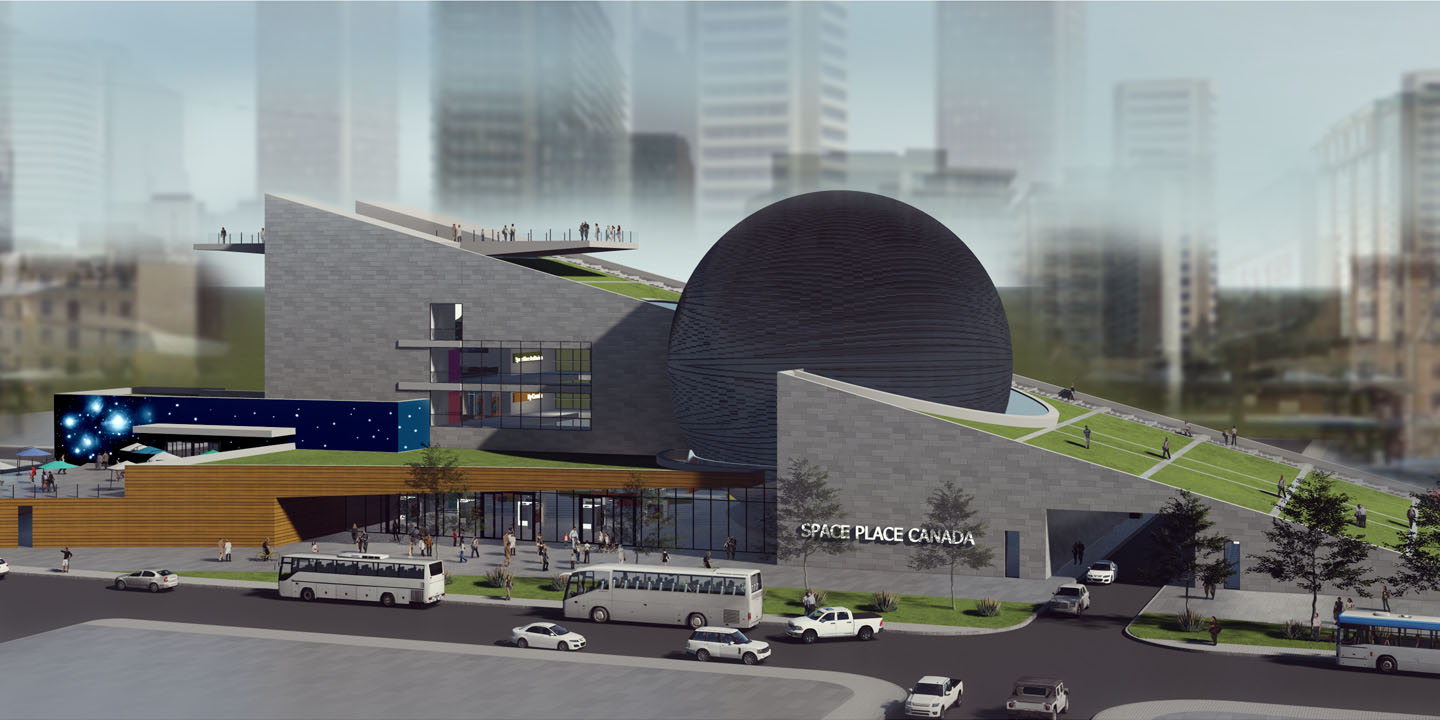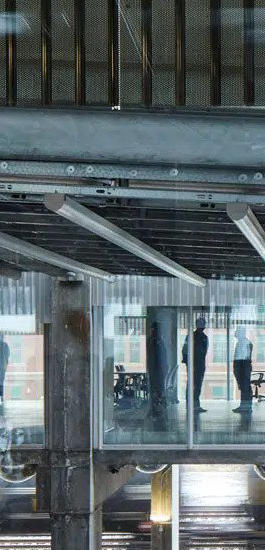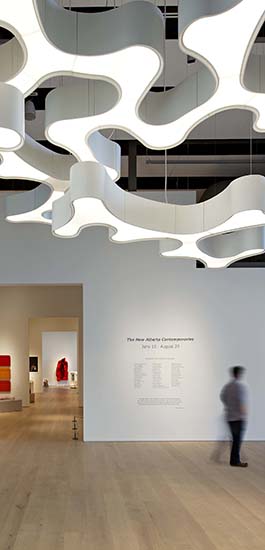The human fascination with space exploration has gained significant momentum in recent decades as our understanding of the universe at large continues to grow richer and more nuanced with each successive discovery. As this fascination grows, so too does the role that planetariums play in society, allowing a new generation to understand our place within the universe.
Over the years, the design of planetariums and observatories has changed dramatically. While their fundamental purpose remains the same – to facilitate exploration, study, and community – architecture and technology has advanced to create spaces that are more immersive and awe-inspiring.
Unparalleled experience in planetarium design
As a Senior Advisor and Architect at Kasian, I have had the unique experience of designing planetariums for over four decades. It all began in 1985 when we were commissioned to design the new tilted dome planetarium at the Calgary Science Centre.
Up to then, planetariums were almost universally horizontally inclined. Their presentations were primarily star shows projected through a centrally-positioned star projector mixed with psychedelic laser shows backed by exceptionally loud rock music. In Calgary, we modelled the new tilted dome theatre after a very successful experimental planetarium in Finland. We introduced a movie projector that provided full dome video, a giant slide projector, and new laser and video projectors. We created a stage to enable live presentations which were integrated into the projected images. This theatre became the benchmark for modern planetarium design worldwide.
Since the Calgary Science Centre, where we gained a reputation for being great collaborators with the projector industry, our firm has been sought out by planetarians from all corners of the globe. Projects include the Eugenides Planetarium in Athens, Greece; the Shenzhen Children’s Palace Planetarium in Shenzhen, China; the Songam Space Centre in Seoul, Korea; the Adler Planetarium in Chicago, USA; and the Palais de la Decouverte Planetarium in Paris, France, just to name a few.
Since the 1980s we have worked with the world’s leading planetarians and planetarium programming experts, giving us tremendous insights into the evolution of these observatories and how design can best support this heightened exploration of the cosmos.
Design strategies for the modern planetarium experience
Globally, planetarium enthusiasts are demanding more meaningful, interactive, and immersive encounters. Based on my experience I’ve developed nine key design factors and considerations that help to create a truly exceptional planetarium experience, drawing in a new generation of visitors.
1.Engage the right experts
With an international planetarium build, it is necessary to work with a local architect. However, there is tremendous value in bringing in an external architectural firm that specializes in planetarium design, like Kasian, as a specialist resource.
Our firm has worked extensively in this resource role by engaging in early design workshops and subsequently reviewing the work being produced by the local design team. We have a solid reputation as being a collaborative and supportive partner, embracing the involvement of the suppliers to the planetarium and observatory industry by ensuring “form and function” are equally addressed. Furthermore, we can bring in our team of planetarium expert partners – individuals who have distinguished themselves in the field of astronomy and have acquired advanced knowledge and experience in planetarium design trends.
In action: Multiple projects
We have worked closely with specialist consultants who are experts in planetarium programming and operations, including:
a) Ian McLennan Consulting (the world’s foremost consultant in programming and operations of planetariums and observatories);
b) Bill Peters Consulting (one of the world’s most knowledgeable project managers and technical wizards dealing with all aspects of planetarium and observatory design);
c) Juan Tanus of KeiSpace Design, one of Canada’s foremost exhibit designers; and
d) Projection equipment suppliers, Evans & Sutherland, SkySkan; RSA Cosmos, and others.
2.Design the dome to support an immersive guest experience
Planetarium domes provide widespread angles for viewers, allowing them to take in 180 to 360 degrees of visuals and sound. Making the guest experience as immersive as possible involves designing a dome that is embedded within the audience. To accomplish this, the dome’s spring line must be as low as possible. This takes serious design study and special testing utilizing our customized drawing software.
3.Provide guest seating in support of an optimal viewing experience
Guest seating is an integral part of creating an immersive experience in a planetarium. The correct orientation and placement of seating plays a large role, allowing viewers to move freely while keeping other guests’ lines of sight unobstructed. Whether utilizing a flat floor or a sloped floor, the installation of comfortable and configured seating must be designed so as to allow guests a total view of the dome.
In action: Telus Spark Planetarium renovation, Calgary, Canada (completed in 2021)
We were extremely strategic about creating improved sight lines to the stage and to the dome above. We began by stripping out the old guard rails and seats, which were replaced by custom designed seats that featured some of the longest backs ever created in planetarium theatre seating. They were tall enough to eliminate the need for guard rails.
4.Eliminate extraneous distractions
In a planetarium, the projector is the star of the show. Good design considers all potential sources of distraction, such as bright colours and wayfinding lighting, finding creative ways to eliminate them. By doing so, we create an environment that allows viewers to appreciate the full beauty and wonder of the night sky.
5.Facilitate the production of impactful imagery
Everything possible must be done to produce the brightest, clearest, and highly acute imagery on the projection dome. The production and utilization of impactful imagery is essential for providing a captivating experience, taking the audience on an immersive cosmic journey.
In action: Telus Spark Planetarium renovation, Calgary, Canada (completed in 2021)
The recent insertion of eight new projectors at TELUS Spark has earned the centre the reputation of having the brightest, clearest digital images in any planetarium in the world today. Only the upcoming technology associated with LED domed screens will outshine this current installation.
6.Be strategic about projector placement
While crisp and immersive imagery is key, it’s equally critical to make the source of the photos and videos invisible to the audience. By hiding the projectors from guest view, we reinforce the sense of magic, leaving viewers wondering ‘where is the imagery coming from’? Since shadowing detracts from the immersion experience, it is also essential to carefully situate projectors such that projector interference is completely eliminated.
In action: The Jennifer Chalsty Planetarium at the Liberty Science Centre, Jersey City, USA (completed in 2017)
Our design involved the installation of eleven projectors in various locations at the perimeter of the dome that remains entirely hidden from audience view during shows. This planetarium has the distinction of being the largest planetarium in the Western Hemisphere. Guests are awe-struck by the impactful imagery and mystery around where the projection sources are coming from. The visitor experience is such that the guests truly feel like they are flying through space. Post-renovation, USA Today named the as one of the ‘Best 10 Science Museums in the U.S.’
7.Use state-of-the-art mechanical and electrical systems
Technological advancements in projection/LED systems and sound systems have moved planetariums away from “planets” into full-scale, immersive theatrical experiences that allow visitors to explore outer space indoors. The ‘out-of-this-world’ experience of visiting a planetarium can be maximized through the usage of these state-of-the-art mechanical and electrical systems. Using these advanced systems help a planetarium reach its fullest potential as an educational and entertaining facility.
8.Design for optimal behind-the-scenes operations
Ensuring a seamless behind-the-scenes operational flow is just as important as the audience-facing elements in planetarium design. A well-designed control room, one that offers operators clear visibility of the entire dome at all times, provides a foundation for reliable daily operation.
It’s equally important to design for ample service space behind the dome to allow for appropriate sound and mechanical equipment and to permit operators and maintenance personnel to conveniently and adequately perform their work.
In action: Eugenides Planetarium, Athens, Greece (completed in 2003)
At the Eugenides Planetarium in Athens, we provided extensive “behind the dome” service space to accommodate large mechanical ductwork (for acoustical reasons), catwalks, a rotating ladder to service the dome, storage space, and much more.
9.Barrier-free design in support of inclusivity
Inclusivity has become a vital part of modern design, and planetariums and observatories are no exception to this. People with physical and mental challenges make up a large portion of the planetarium customer base and being mindful of the range of abilities and ages of the audiences attending these spaces must be kept top of mind. Some of the design elements that may be taken into consideration include ramps in place of stairs, wider doorways, non-slip surfaces, strategically placed handrails, and audible warning signals and Braille signage for those with visual impairments.
In action: Trottier Observatory at Simon Fraser University, Burnaby, BC (completed in 2015)
Barrier-free accessibility was one of the leading design requirements for the Trottier Observatory. Typically, observatories have ramps and stairs centered around one big telescope. We engaged PlaneWave Instruments, a supplier of observatory-class products and telescopes, to reconfigure the telescope for optimal accessibility. The result is a telescopic eye piece adaptation that is unique to the Trottier Observatory.
We designed the interior of the observatory to be completely flat, with no need for stairs or ramps. Comfortably accommodating up to 30 people, the space provides exceptional acuity for astronomers of all abilities.
Setting the bar for planetariums around the world
Deploying a modern design strategy creates state of the art planetariums and observatories that augment audience immersion, drive cosmic curiosity, and leverage the latest advancements in projection and sound technologies to produce an unforgettable experience.
Our team has built unparalleled design expertise, working with the following planetariums and observatories around the world:
Adler Planetarium in Chicago, USA
Astronomy Discovery Centre at the Lowell Observatory in Flagstaff, USA
Calgary Science Centre in Calgary, Canada; now known as Contemporary Calgary
Eugenides Planetarium in Athens, Greece
Guangzhou Planetarium at the Science Centre in Guangdong, China
Jennifer Chalsty Planetarium at the Liberty Science Centre in Jersey City, USA
Palais de la Decouverte Planetarium in Paris, France
Royal Astronomical Society Calgary Centre Observatory at Ralph Klein Park in Calgary, Canada
Science North Planetarium in Sudbury, Canada
Science World Dome Theatre in Vancouver, Canada
Shenzhen Children’s Palace Planetarium in Shenzhen, China
Songam Space Centre in Seoul, Korea
Space Place Canada Planetarium in Toronto, Canada
TELUS Spark Infinity Dome in Calgary, Canada
Trottier Observatory and Science Park at Simon Fraser University in Burnaby, Canada
Versant Power Astronomy Centre in Orono, USA
Read Next
Article
Bill Chomik’s story: in his own words
By: Kasian
Portfolio
Explore our full arts & culture portfolio
By: sanya persaud
We’d love to get to know you
Get in touch
"*" indicates required fields
Get in touch
Share




